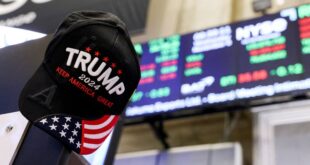This is The Takeaway from today’s Morning Brief, which you can sign up to receive in your inbox every morning along with:
Risk markets are off to an ominous start this October.
After a blistering rally over the first nine months that led the S&P 500 (^GSPC) to its best performance since 1997, the benchmark just had its worst day in three weeks on Tuesday.
Geopolitical tensions and an Iranian missile strike on Israel are dominating headlines, pushing crude oil prices higher as fears of supply disruptions escalate. The first strike by the International Longshoremen’s Association since 1977 — threatening supply chains once again and potentially shuttering ports from Houston to Boston — isn’t helping.
But there’s another key driver adding structural bullishness to commodities: China’s largest stimulus package since the pandemic, with the promise of more to come.
Last week, China unleashed a suite of monetary and fiscal easing measures, catapulting China’s benchmark CSI 300 Index (000300.SS) 27% from its September lows into fresh bull market territory.
New support for China’s beleaguered housing market this week adds to prior measures — including support for Chinese-listed stocks — which all told now total over $500 billion (though estimates vary widely).
These aggressive actions are already reverberating through global commodity markets. Iron ore futures have surged over 20% in China, leading Jim Bianco, president of Bianco Research, to weigh in on X:
“The Chinese finally stimulating domestic demand gives hope that they will start to consume more. This idea is significantly contributing to this unfolding rally in industrial metals.”
Connecting the dots, it’s a short trip to higher energy prices. As Bianco notes, “The Chinese consume more energy than the US or the EU.”
Institutional investors have been caught flat-footed all around. According to the BofA September Global Fund Manager Survey, China’s growth expectations had fallen to a record low. Any shorts have likely been sent scrambling.
Meanwhile, WTI (WTI) and Brent (BZ=F) crude oil are surging with Iran’s missile attack on Israel, with the former jumping nearly 8% Tuesday.
But US consumers might not feel the pinch in oil and gas prices, as OPEC+ was already on track to increase production by 180,000 barrels per day, starting in December. The move, spearheaded by Saudi Arabia, would increase their market share at the expense of lower prices.
For US stock investors, there may be a trade to capitalize on in the confusing geopolitical melee. In a separate report published Tuesday, BofA Global Research upgraded the Materials sector (XLB) to Overweight, saying that the sector has the highest correlation to China’s economic growth.
BofA noted that large-cap materials suffered the most when the Federal Reserve aggressively raised rates starting in 2022. It also highlighted the sector’s underweight positioning by long-only managers, both of which leave room for a potential re-rating as China’s demand accelerates.
“Underinvestment in manufacturing, single-family [homes], [and] mining over [the] last decade should drive [materials prices] higher,” noted the bank.
Commodities, it seems, are primed to have a moment.
Click here for the latest stock market news and in-depth analysis, including events that move stocks
Read the latest financial and business news from Yahoo Finance
Source link
 meganwoolsey Home
meganwoolsey Home


